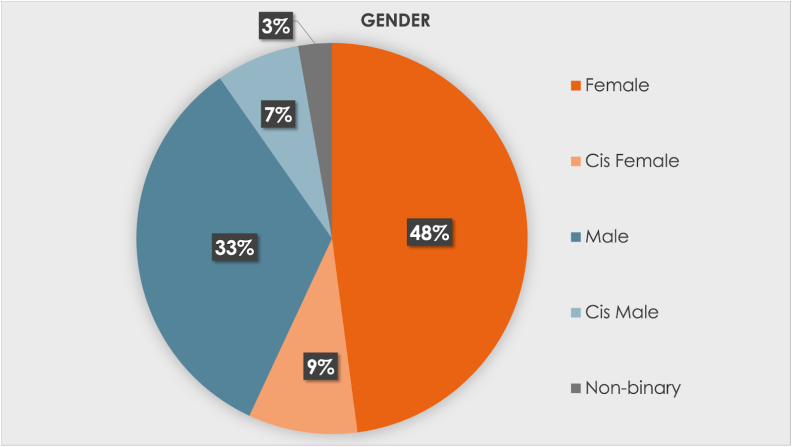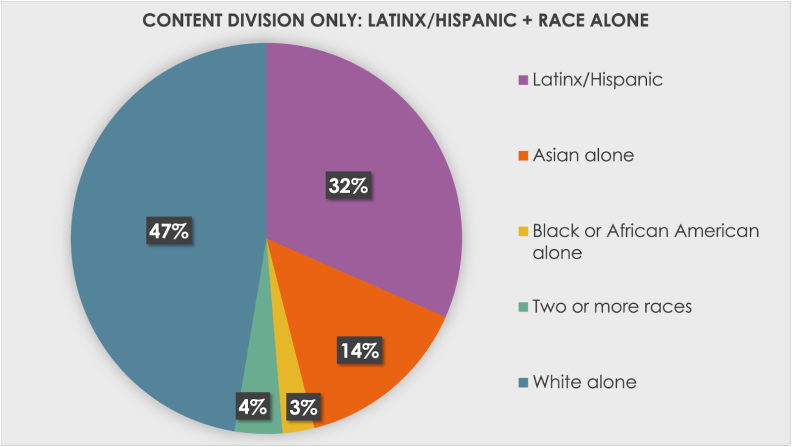In 2020, Southern California Public Radio formed an independent task force to assess the organization in terms of diversity, equity, and inclusion, and to make a set of recommendations to the executive team and board of trustees.
More than 90 percent of staff engaged with the task force, as did former employees, board members, Regional Advisory Council members, and independent DEI consultants. In March 2021, the task force produced its final report, including a set of 44 specific recommendations for advancing a diverse, equitable, and inclusive culture across SCPR. Based on those recommendations, the executive team developed an implementation plan that includes producing and publishing an annual staff demographics survey.
At SCPR, we believe that diversity, equity, and inclusion—in everything we do—are critical to our success. Our commitment to our ongoing DEI implementation plan is a reflection of that.
Our survey was conducted in December 2021. The results are based on how 149 of 169 active employees self-reported. Due to rounding or unavailable data, the values do not always sum to 100 percent. The charts reflect answers from all respondents, except where otherwise noted. This data was collected as part of an optional survey for all staff. It is separate from the data used by Human Resources; that data is more limited and is collected at the time of an employee’s application to work here. Here are the results of our December 2021 self-reported staff demographic survey.
Race and Ethnicity
- 53% of SCPR employees identify with a race or ethnicity other than white alone, which is reflected in the chart below.
- 43% of supervisors identify with a race or ethnicity other than white alone.

The following chart compares the Latinx/Hispanic + race makeup of Southern California Public Radio with that of Los Angeles County.

- When we look at race alone, without factoring in Hispanic-Latinx identity, 43% of SCPR employees identify with a race other than white alone.

- A note on staff who identify as more than one race: The survey provided staff with two different opportunities to indicate whether they identify as biracial or multi-racial. One question asked directly: “Do you consider yourself to be biracial or multi-racial?” Separately, the question on race included the dropdown choice “Two or more races.” Answers were not always consistent between the two questions. When accounting for all staff who either answered “yes” to the multi-racial question or selected “Two or more races” for the race question — or both — the total percentage who identify as biracial or multi-racial rises to 23%.
Nearly three-quarters of staff have been hired within the last 10 years—more than half in the last five years.

The racial and ethnic diversity of staff has also increased over the past 10 years.

Gender and Sexuality


- 62% of staff use pronouns other than he/him.
- The same percentage of supervisors use pronouns other than he/him.
- 22% of staff who responded to the survey identify as LGBTQ+.
Thirteen people declined to share their sexual orientation. Responses such as gay, pansexual, queer, fluid, straightish, lesbian, LGBTQ, bisexual, and homosexual were coded as LGBTQ+.
A Closer Look at the Content Division
- 55% of respondents self-identified as part of the content division.
- Within the content division, 53% identify with a race or ethnicity other than white alone.
- 42% of supervisors within the content division identify with a race or ethnicity other than white alone.

- 64% percent of content respondents use pronouns other than he/him.
One person declined to answer.
- 23% percent of content respondents identify as LGBTQ+.
Six people declined to answer.
More About Respondents


